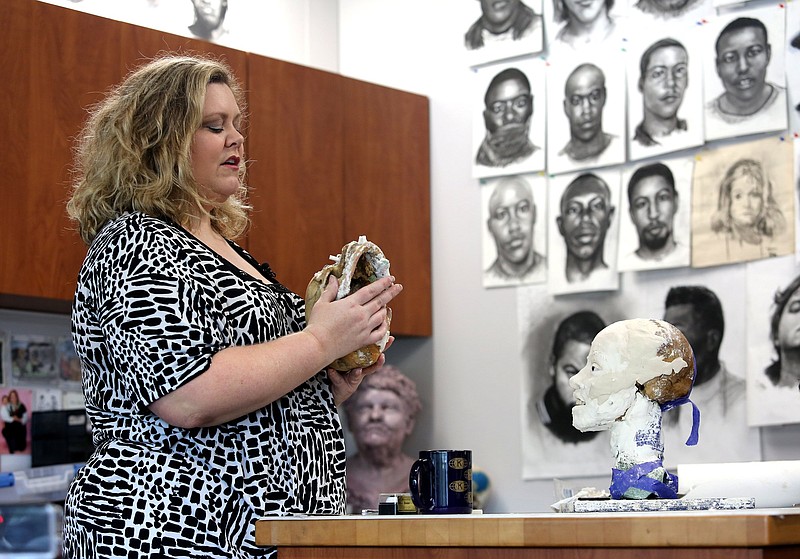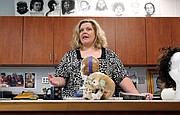DECATUR, Ga. - In her office at the Georgia Bureau of Investigation's headquarters last week, under a matrix of black and white sketches, Kelly Lawson spread clay across a skull's forehead.
She already stuffed the holes of the skeleton with Styrofoam, to block the clay from seeping in. Eraser pieces dotted 24 spots across its face, markers of how thick the clay should sit in each location. Plastic, brown eyes filled the sockets.
Sculptures like these take just over a week. But when she finishes, Lawson hopes to have an accurate rendering of what the victim once looked like, before investigators found her remains.
Hoping a family member or friend recognizes a familiar aspect of one of her sculptures, Lawson's work is police officers' best chance to identify some victims. But she concedes there's only so much she can do. When she begins a project, she stares at the features of the skull for several minutes, photographs it from different angles and prays.
"So much of this job is very spiritual," she said. "There's certain things, even [with] my greatest ability, I can't figure out."
A GBI forensic artist since May 2012, Lawson travels to crime scenes across the state to draw composites of suspects and homicide victims. She estimates facial reconstructions account for only about 10% of her cases.
Investigators displayed two of Lawson's sculptures locally in the last month. On March 25, the GBI and Dade County Sheriff's Office held a news conference in Trenton, displaying a new rendering of a woman found dead off Interstate 59 in 1988. (Lawson's predecessor, her mother, previously did a reconstruction in the case, but the old sculpture's paint became green.)
On March 19, the GBI and Chattanooga investigators also held a news conference with Lawson's rendering of a woman found dead in Wildwood, Georgia, in September 1981. Serial killer Samuel Little took credit for that killing last year, saying he picked the woman up at a bar on Martin Luther King Boulevard in Chattanooga.
"We'd like to get some closure to this family," GBI Special Agent in Charge Joe Montgomery said last month.
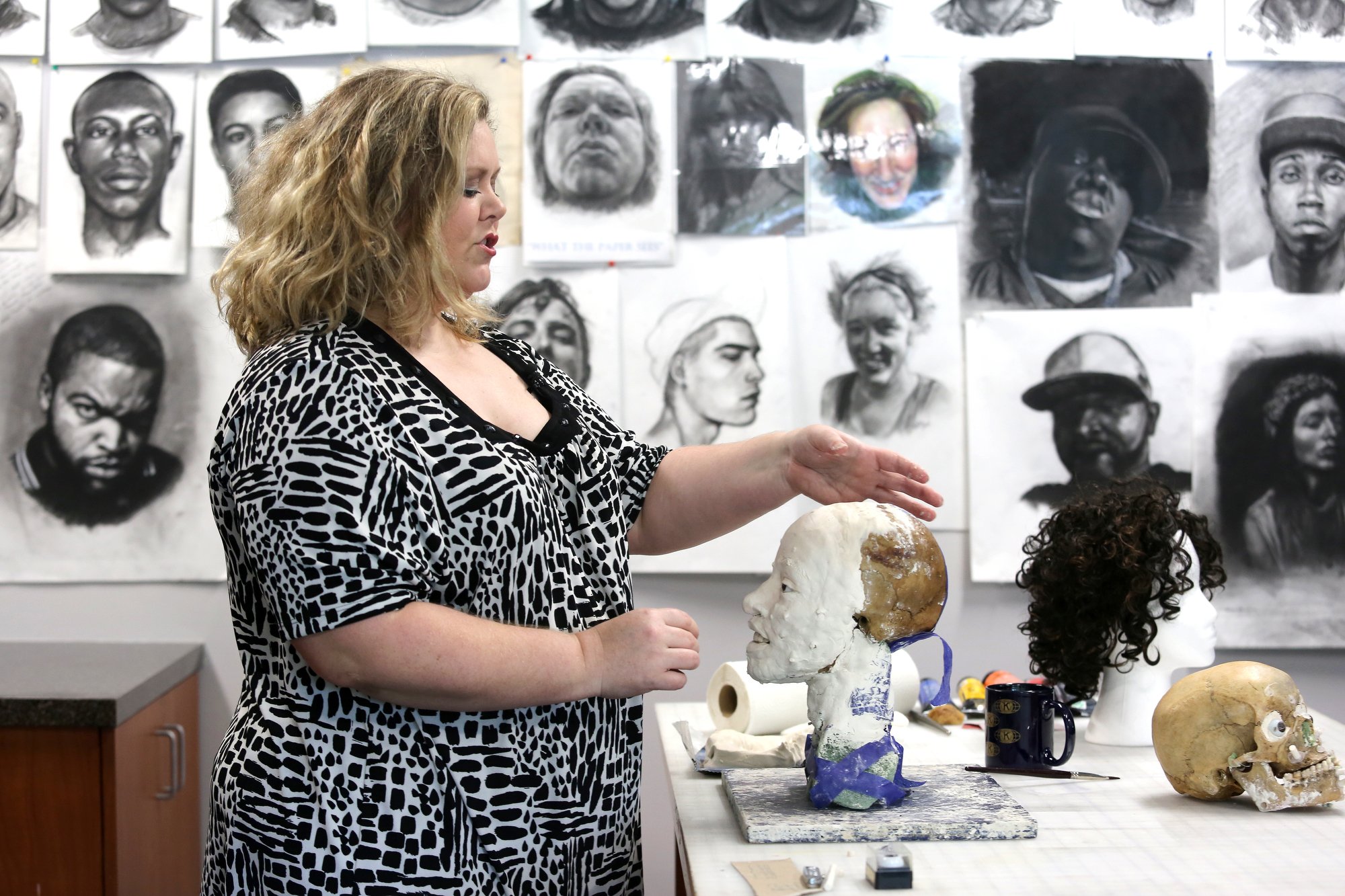 Kelly Lawson, a forensic artist at the Georgia Bureau of Investigation, works on a forensic facial reconstruction Tuesday, April 9, 2019 at the GBI Headquarters in Decatur, Georgia. Lawson helps investigate cases in which people stumble across dead bodies and cases in which a suspect needs to be found based on a drawing.
Kelly Lawson, a forensic artist at the Georgia Bureau of Investigation, works on a forensic facial reconstruction Tuesday, April 9, 2019 at the GBI Headquarters in Decatur, Georgia. Lawson helps investigate cases in which people stumble across dead bodies and cases in which a suspect needs to be found based on a drawing.The process
Before Lawson receives the skull, Kennesaw State University anthropology professor Alice Gooding examines the bones. She studies and measures the pelvic joints, ribs and cranial sutures. The size, shape, texture, weight and porosity of the bones tell Gooding key characteristics.
She can inform Lawson of the person's biological sex and ancestry, as well as an estimate of the person's age. Because a skeleton does not break down at a regular rate, Gooding said, there is variation in how bodies deteriorate. She cannot provide an age window narrower than 5 years; sometimes the window is as wide as 30 years.
But Lawson is more confident with these details. Based on ancestry and sex, she determines the depth of facial tissue at 24 different points, as outlined in a textbook by an FBI forensic art instructor. The spots run down the middle of the face, from the forehead to the chin. They also dot the jaws and eyes.
Each spot is marked with an eraser, varying by the millimeter depending on how deep the tissue likely is on that part of the skull. The erasers tell Lawson how thick to apply the clay around that spot.
With an estimate of the subject's age, Lawson will sculpt differently. She probably will give an older subject loose jowls and crow's feet around the eyes.
Small details in the skeleton give her leads on the shape of the nose and eyes, too. She searches the inside of the eye sockets, looking for a small notch on the outer corner. This is the point where the eyelids meet. If the notch is low, the upper eyelid drops farther to meet the lower one. Lawson will give a subject like this droopy eyes.
These clues make a good estimation, but plenty of areas are open to interpretation. Even if she knows the skull's race, she does not know its skin tone. The eyebrows sit along the brow line, of course, but Lawson can't know if they were bushy or thin.
"You use a little bit of intuition, a lot of your gut and a lot of just the science that we have at our disposal," she said.
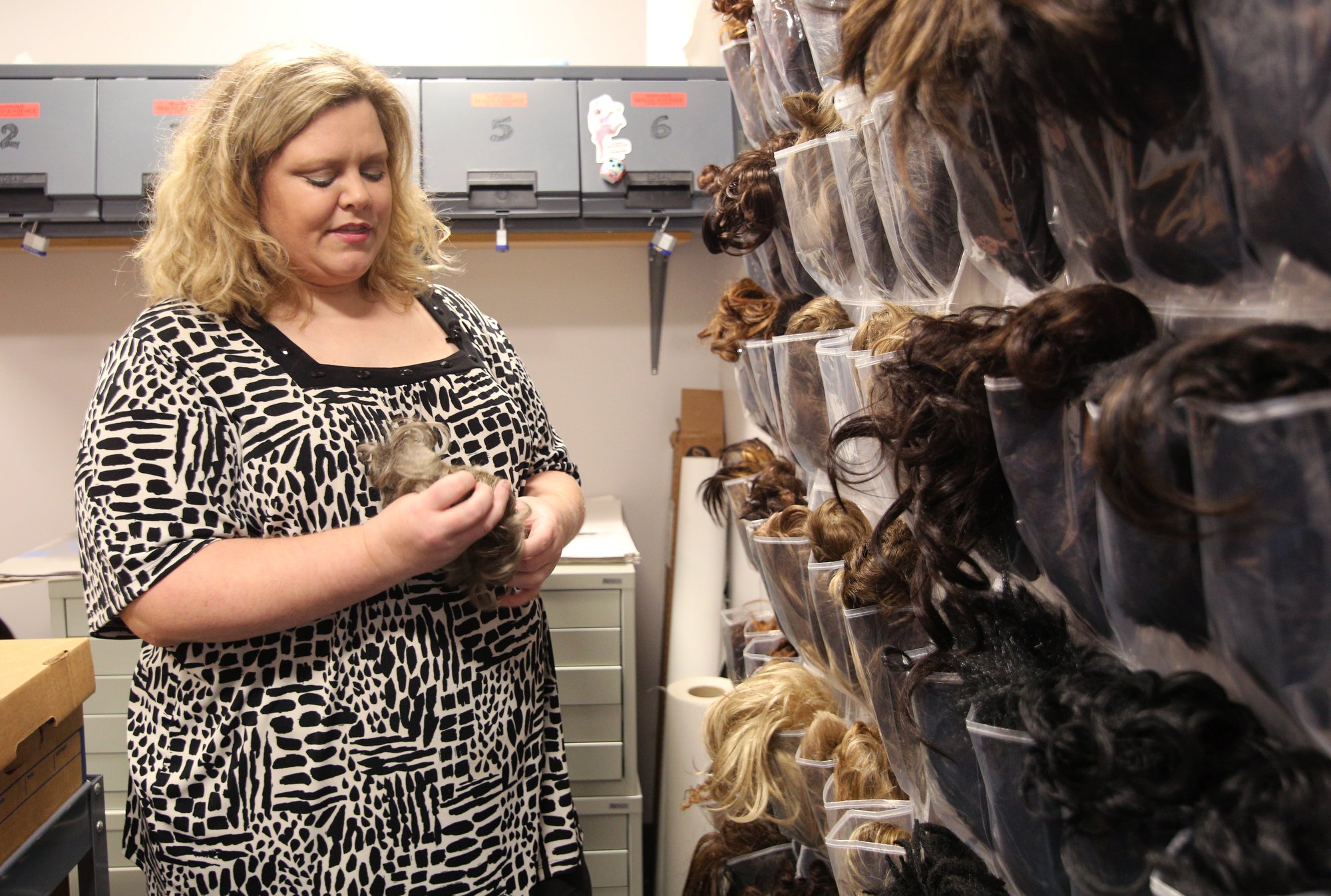 Kelly Lawson, a forensic artist at the Georgia Bureau of Investigation, shows off wigs she created with donated hair Tuesday, April 9, 2019 at the GBI Headquarters in Decatur, Georgia. Because there were some hair types Lawson couldn't get out of purchased wigs, she asked employees at the GBI to donate hair, so she could make her own wigs for reconstructions.
Kelly Lawson, a forensic artist at the Georgia Bureau of Investigation, shows off wigs she created with donated hair Tuesday, April 9, 2019 at the GBI Headquarters in Decatur, Georgia. Because there were some hair types Lawson couldn't get out of purchased wigs, she asked employees at the GBI to donate hair, so she could make her own wigs for reconstructions.Foundation
At the core, forensic artists owe a debt to the Italian sculptor Giulio Gaetano Zumbo, who made a name for himself in the second half of the 15th century by casting wax over real skeletons. He aimed to show the decomposition of the human body, and critics celebrated his horrific scenes for intent scientific precision, anthropologist Caroline Wilkinson wrote in "Forensic Facial Reconstruction."
Zumbo's work inspired an "anatomica plastica" in the 1700s. Artists hosted shows throughout Europe, displaying creative interpretations of veins and muscles on real bones.
"Although the 'anatomica plastica' artists did not intend to create a good likeness of the individual, it is clear from viewing the models that they must resemble the individuals," Wilkinson wrote.
More concretely, anatomists Hermann Welcker and Wilhelm His created the foundation for facial reconstruction in the 1890s. To study tissue depth, Welcker inserted surgical blades into the faces of cadavers, recording how deep the blade dug. He later added a small piece of rubber to a thin needle and penetrated faces that way. The rubber reduced damage done to the issue, which gave more accurate results. (Welcker and His also helped reconstruct Johann Sebastian Bach's face after his bones were dug up more than 100 years after his death.)
In the mid-20th century, American anthropologist Wilton Krogman became the founder of the facial reconstruction movement among law enforcement. As a professor at the University of Chicago's Oriental Institute, Krogman studied thousands of skeletons dug up from Anatolia and Iran, anthropology professor William Haviland wrote in a biography for the National Academy of Sciences.
In 1946, he photographed the face of a cadaver. As an experiment, he let the body waste away for about a month before giving the remains to a sculptor. He gave her the appropriate tissue thickness for parts of the face and asked to build over the skull. He concluded her work resembled the real person closely enough for a relative to identify the remains.
Krogman wrote about the experiment in the FBI's Law Enforcement bulletin and spent decades teaching law enforcement officers how to perform the craft.
The craft became more famous in 1980, when forensic artist Betty Pat Gatliff sculpted facial reconstructions for nine of serial killer John Wayne Gacy's victims. (In her textbook, FBI forensic art instructor Karen Taylor wrote that Gatliff's work led to at least one positive identification.)
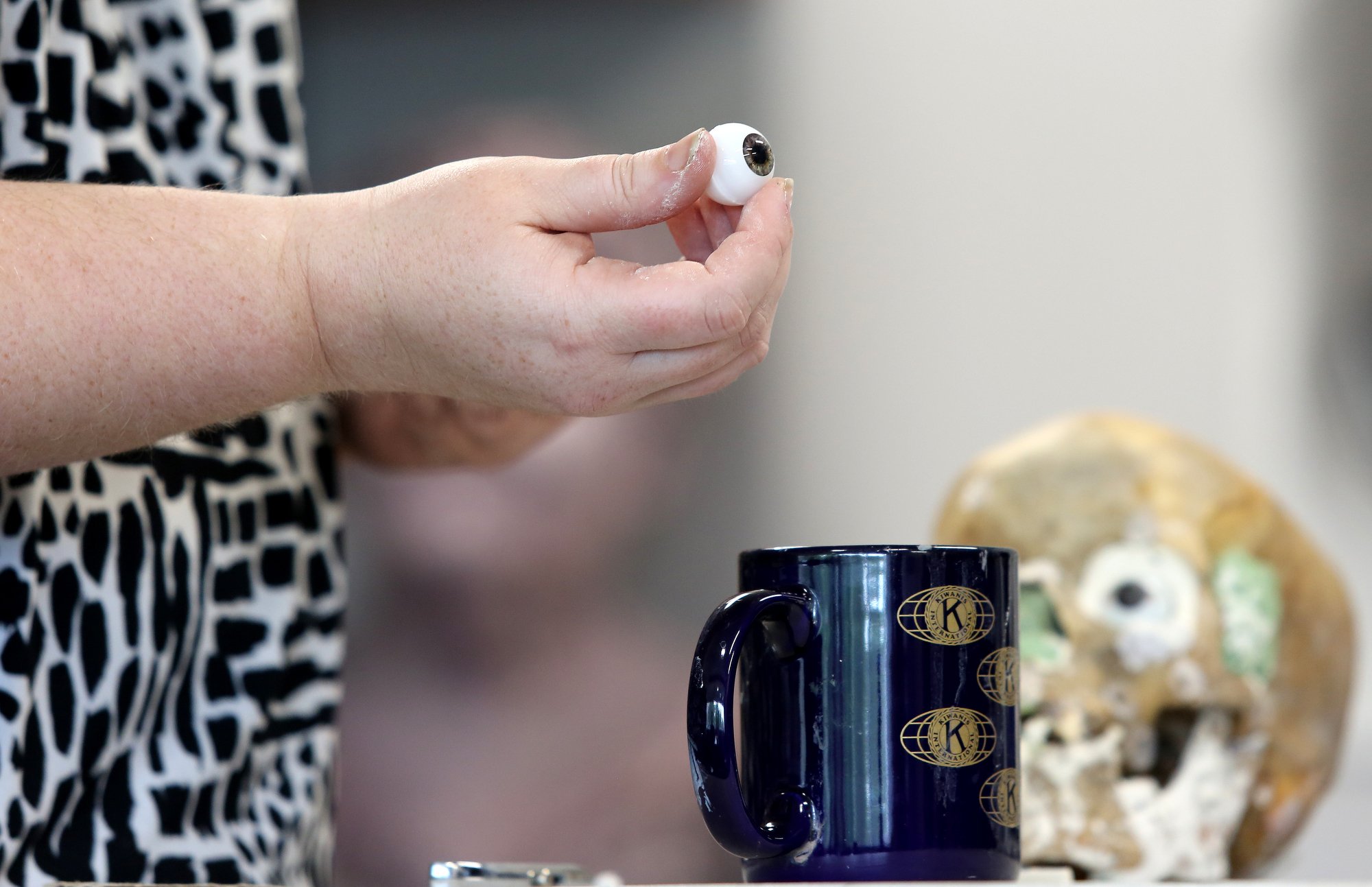 Kelly Lawson, a forensic artist at the Georgia Bureau of Investigation, shows off the lifelike eye used in forensic facial reconstructions Tuesday, April 9, 2019 at the GBI Headquarters in Decatur, Georgia. Lawson said that placing the eyes is one of the first few things she does when working on a reconstruction. Most of the time, she said she uses brown eyes because a majority of the population has brown eyes.
Kelly Lawson, a forensic artist at the Georgia Bureau of Investigation, shows off the lifelike eye used in forensic facial reconstructions Tuesday, April 9, 2019 at the GBI Headquarters in Decatur, Georgia. Lawson said that placing the eyes is one of the first few things she does when working on a reconstruction. Most of the time, she said she uses brown eyes because a majority of the population has brown eyes.Family craft
When Lawson joined the GBI, she apprenticed under her mother, Marla Lawson, the state's first forensic artist. Even by the standards of a professional creative, Marla Lawson is quirky.
She had a knack for drawing as a child and tried to study the craft formally after high school.
"Everybody would get high and go to the Atlanta School of Art," she said during an interview last week. "I didn't know what they did. But it sounded fun."
Instead, the owner of an art store in Underground Atlanta hired her to draw caricatures for $20 outside his shop. She liked the job, until someone kidnapped her. She said she escaped before the culprit could do any damage. ("I yelled, 'Up yours!' and ran up the hill in high-heeled boots," she told the Times Free Press, with a dash of cheer.)
She worked other odd jobs, including a stint as a Subway sandwich artist and a Coweta County jail officer. ("I was the worst guard they had. There would be a riot going on down there, and I'd ask one of [the inmates] to help me. He said, 'What are you going to do if I help you?' I said, 'I'll bring you bubble gum.' So I brought them bubble gum the next day. What I didn't know was they were going to stick it everywhere.")
She joined the Atlanta Police Department in 1975 as a records clerk. Her father, a lieutenant, told his co-workers she was a great artist. Officers began asking her to sketch their faces on the clock. Eventually, they leaned on her talent to sketch rapists and robbers, based on witness statements.
She worked high-profile cases, including the Atlanta Child Murders from 1979-81 and the Centennial Olympic Park bombing in 1996. Her sketch of Eric Rudolph became famous. And after his conviction, she said, he called her from prison to ask if he could use her drawing for the cover of his memoir. She forwarded the call to the GBI's legal department.
Marla Lawson said she loved the work, but she got tired. Forensic art makes for long hours, with late-night drives to crime scenes throughout the state. The job was not emotionally taxing for her. She did not think about the pain inflicted on the bones she worked with. Still, she noticed she lost empathy for some victims she worked with. She caught herself wondering why some were so dumb as to put themselves in a position to be hurt.
As she looked for a replacement, she was unsatisfied with a group of candidates. (Kelly Lawson describes her mother as "old school," unafraid to bluntly criticize an artist.)
Finally, she asked her daughter to draw a man, based on a photo. Kelly Lawson, who studied art at Brigham Young University, had been working as a medical debt collector. Marla Lawson believed she could mold her daughter, and she convinced her to take the job.
"She gave me one of the greatest compliments she's ever given me in her whole life," Kelly Lawson told the Times Free Press. "She said, 'It ain't great. But it's better than what the other guys were doing.'"
She has found the work as satisfying as her mother did. A sketch doesn't always lead to an arrest or an identification. But listening to victims makes her feel helpful. At the same time, the work carries urgency.
"There are people crying to you from the dirt for a name," Marla Lawson said. "Who can quit?"
Contact staff writer Tyler Jett at 423-757-6476 or tjett@timesfreepress.com. Follow him on Twitter @LetsJett.
